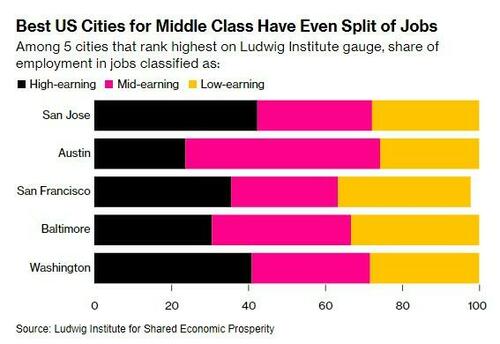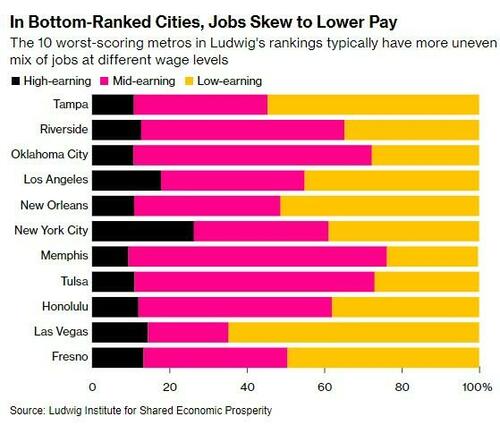New Study Finds That Costlier U.S. Cities Offer Better Middle And Lower Class Living Standards
As the ole’ expression goes: money talks and bulls**t walks.
That appears to be the theme of a new study by the Ludwig Institute for Shared Economic Prosperity, which found this week that paying up to live in some of the major cities in the U.S. could offer the best living standards for middle class and lower class households.
The report, cited in a new Bloomberg article, found that the institute’s analysis, which evaluates the economic welfare of middle- and working-class residents in the 50 largest US metro areas, indicates that the elevated wages in these locations more than compensate for the increased costs.
The study used criteria like the price of essential goods and services, their inflation over the past 20 years, wages, and general employment indicators. A crucial observation is that top-performing cities usually offer a more balanced variety of jobs across different pay levels.
It also monitors variations in prices of necessities such as housing, food, and childcare, and contrasts these with the median weekly earnings of the entire workforce, encompassing part-time workers and job seekers, who are often omitted from many wage assessments.
San Jose, California, emerges as the leading city in this respect. San Jose tops 50 metros in disposable income and ranks fourth in spending power growth since 2005.
Conversely, Seattle lags, with living standards not matching price rises. New York City and other costly metros like Los Angeles rank poorly on the Ludwig scale for middle- and working-class families, partly due to a high proportion of low-paying jobs.
For instance, Las Vegas and Miami have 63% and 56% of workers in low-wage roles, respectively, compared to the national average of around 35%. Better-performing cities in Ludwig’s ranking, such as Austin and Baltimore, have even lower percentages of low-wage jobs.
Gene Ludwig, head of the institute, said: “Across the nation we are seeing both ends of the spectrum — communities where middle- and working-class families are faring well and others where financial survival remains a struggle.”
Bloomberg also noted that 60% of Americans struggle to afford basic needs, a situation worsened by the pandemic-induced surge in essential living costs, notably housing.
A US Senate Joint Economic Committee analysis indicates that, as of October 2023, an average US family requires an additional $11,400 annually to maintain their 2021 living standards. However, in costly metros like San Jose and San Francisco, higher salaries help counterbalance these increased expenses. The Ludwig researchers specifically examined the disposable income of median earners after covering essential monthly costs, the report said.
Philip Cornell, a member of the research team, added: “A lot of cities are actually negative with that. If you’re a median earner in Los Angeles and you’re just trying to meet your basic needs, you’re falling behind. Whereas in San Jose, the median earner is doing better.”
Tyler Durden
Thu, 11/23/2023 – 22:45
via ZeroHedge News https://ift.tt/7m8J524 Tyler Durden

